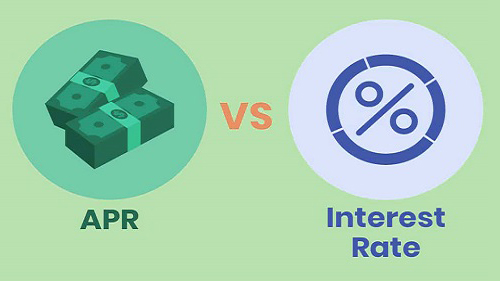
Mortgage Dove
What's the Difference Between Interest Rate and APR?
Understanding the difference between interest rates and APR is crucial when borrowing money for a mortgage, car loan, or credit card. While these terms may seem similar, they have distinct meanings and can impact your financial situation.
In this article, we will delve into the nuances of interest rate and APR, why they matter, and how they affect your loans. Whether you are a borrower seeking a loan or simply interested in understanding how borrowing costs work, read on to learn this critical factor. We will also discuss strategies to consider when entering into loan agreements and how interest rates and APR can impact your monthly payments, total loan costs, and long-term financial goals.
What Is Interest Rate?
Borrowing money from a lender incurs an interest rate. If your mortgage interest rate lasts the life of your loan, it will remain the same throughout your loan. Your mortgage interest rate may also be variable, depending on market conditions.
Your interest rate will always appear as a percentage. As the borrower, you repay the loan's principal and interest.
Let's consider an example. Suppose you borrow $100,000 to buy a home at 4% interest. At the beginning of your loan, your mortgage accrues 4% interest every year. In other words, that's $333.33 a month or $4,000 a year.
The principal balance on your loan will be high at the beginning of the term, so you'll pay more interest. By making monthly payments, you will owe less interest and more of your payment will go toward the principal. It is called mortgage amortization. It is called mortgage amortization.
What Is APR?
When comparing loans, the annual percentage rate (APR) is the most effective rate to consider. This figure includes not only the interest expense on loan but also all fees and other costs involved in obtaining it. The broker's fees, closing costs , rebates, and discount points all fall under this category. These often appear as percentages. When a lender offers a rebate on a portion of your interest expenses, the APR should always be higher or equal to the nominal interest rate.
Borrowers need clarification when two lenders offer the same nominal rate and monthly payment but with different annual percentage rates. As a result, the lender with the lower APR requires fewer upfront fees and offers a better deal.
There are a few caveats associated with the use of the APR. Your mortgage may be more expensive if you refinance or sell your home than it would have been if lender servicing costs were spread out over the loan's term. Furthermore, it is impossible to predict the future direction of interest rates, so the APR cannot accurately reflect the actual cost of an adjustable-rate mortgage.
Interest Rate vs. APR
An interest rate and an APR measure how much it costs to borrow money from a lender for a specific period. However, their calculation, what they represent, and the degree of control a borrower has are all different.
When entering into agreements, there are also strategies to consider. Suppose a home buyer wants to minimize their interest rate or APR. The lowest rate may seem appealing but may only sometimes be the best option for a buyer.
To secure the lowest monthly payments, the borrower may pursue the lowest interest rate. Imagine a situation in which a lender can choose between two loans charging 5% and 4% with two discount points (~2%). Higher interest rates may be beneficial in this situation.
Interest Rate
- Narrower look at borrowing costs
- Your loan does not include any other fees
- Based on the client's individual data (e.g., credit score)
- In case you do not plan on staying in your home for long, it might be more beneficial (due to the breakeven point for fees)
- A lower rate often translates into lower monthly payments, although the total loan may still be more expensive
APR
- A broader look at borrowing costs
- Your loan includes points, origination fees, broker fees, and closing costs
- Mostly controlled by the lender (e.g., discount points and broker fees).
- Long-term homeowners may find it more advantageous (due to APR assumptions over the entire term)
- A lower APR often translates to a lower total loan cost, although monthly payments may be higher
How Are Interest Rates Calculated?
You might ask, "How are mortgage rates calculated?" It depends on the information you provide to the lender. Every lender uses a formula to determine how much interest you will pay. You can get ten different interest rates from ten mortgage providers. To determine your interest rate, the lender will also consider current market interest rates and real estate economic conditions.
A mortgage lender can lower your interest rate in several ways. Any action to reduce your lender's risk will usually result in a lower rate. Your first step should be to improve your credit score, which shows lenders how you use credit. High credit scores indicate that you pay on time and only borrow what you can afford.
Lenders are more likely to turn you down if you have a low credit score. When you have a history of missing payments on your loan, a lender might offer you a higher interest rate.
You can raise your credit score by following these steps:
- Make sure you pay your minimum loan and credit card payments on time.
- Make sure you use your credit cards sparingly.
- Make every effort to reduce your debt.
- Avoid applying for new loans when getting a mortgage.
Suppose your home falls into foreclosure, and you have a loan insured by the federal government. In that case, the government agency backing your loan will reimburse your lender. A government-backed loan, such as a VA, FHA, or USDA loan, can also lower your interest rate.
You might get a better interest rate with a government-backed loan than with a conventional loan that is not government-backed. However, mortgage insurance will affect your payment, so you should consider all your options.
How Is APR Calculated?
Unfortunately, you are less in control of your APR than your interest rate. Your lender controls other factors affecting your APR, such as origination costs and broker fees.
You can reduce your APR by putting down 20%, avoiding private mortgage insurance, but comparing lenders is the best way.
When using APR to compare rates, make sure you are comparing apples with apples. This means you shouldn't compare the APRs on 30-year fixed-rate mortgages and 5/1 adjustable-rate mortgages (ARMs) from different lenders.
The Bottom Line
The interest rate you pay is a percentage, but the APR includes any other fees and expenses you will incur with your lender. In other words, your APR is the effective interest rate you'll pay once you have your loan. The most common additional fees are brokerage fees, private mortgage insurance, and discount points.
Lenders must tell you your interest rate and APR before closing a loan. Controlling your credit score and choosing a government-backed loan can lower your interest rate. The lender sets many of these costs, so you have less control over your APR. Comparing loan programs from different lenders is the most effective way to find a lower APR.
"Mortgage Dove makes home financing convenient for every American. You can count on us to provide a home buying experience tailored to your personal needs and financial situation. We strive to give you the peace of mind that your home financing goals can be achieved.”

Mortgage®
www.mortgagedove.com



-and-how-does-it-work.png)